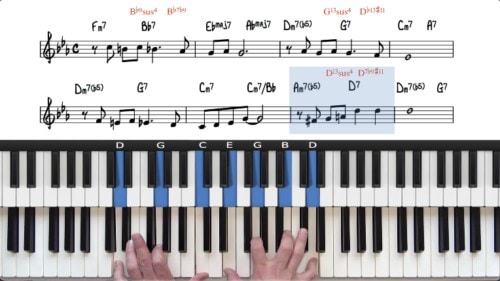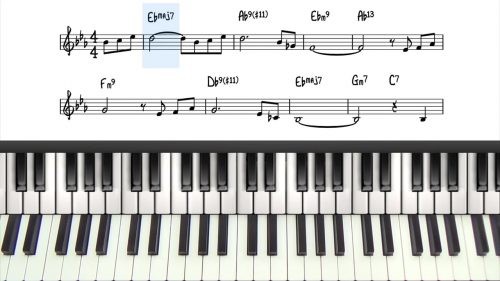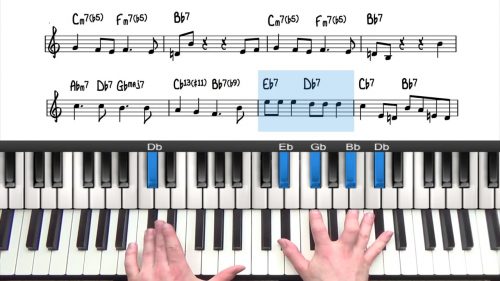“Sentimental Mood” – B Section
Welcome to the 3rd lesson in our exploration of “In a Sentimental Mood”. In this lesson, we turn our focus to the B section – also known as ‘the bridge’ – which spans bars 17 to 24 and introduces a distinct modulation from the key of D minor to the key of Db major.
Understanding the Modulation in the B Section
At the end of bar 16, we encounter a 2-5 progression (Eb-7 and Ab7) which signals an upcoming modulation as the tune shifts from D minor to Db major for the B section. Remember that modulations are most often proceeded with the 2 and 5 chords of the new key; as we explored in the previous module
The modulation to Db Major introduces a brighter tonality, contrasting with the minor feel of the A sections. As you’ve already studied “Body & Soul” in the previous module, you’ll find some familiar harmony and progressions here, in particular the Dbmaj7, Bb7, Eb-7 and Ab7 chords – which are the 1, 6, 2, and 5 chords from the key of Db major.
Breaking Down the 1-6-2-5 Progression
The harmony of the B section is primarily built around the 1-6-2-5 progression in Db major. The 1625 progression is a very common ‘harmonic unit’ found in jazz standards, similar to the 251 and 3625 progressions that we have explored in previous courses. The 1625 chords in the key of Db major are as follows:
- Dbmaj7 (Imaj7 chord)
- Bb-7 (vi-7 chord but often played as a dominant chord)
- Eb-7 (ii-7 chord)
- Ab7 (V7 chord)
This progression repeats, creating a smooth and cyclical harmonic movement. It’s important to understand this progression as you will encounter it in many jazz standards as you progress through the PianoGroove lessons and courses.
Combining Melody & Spread Voicings
We then introduce the melody and voice the chords using 2-handed spread voicings which avoids the chord tones overlapping with the melody. We often play the root and 5th in our left hand and the 3rd and 7th in our right hand with the melody on top. This approach ensures a fuller, more balanced sound when navigating the lush chords in the B section of “In A Sentimental Mood”.
Voice Leading & Sus Chords
When moving between Bb7, Eb-7, and Ab7, maintain smooth voice leading by keeping the chord tones (3rds and 7ths) in close proximity. This technique enhances the fluidity of our chord changes, making the harmony sound smoother and more cohesive.
Towards the end of the B section, we encounter a C7sus chord, which adds a sense of suspension before modulating back to D minor for the final A section. A C7sus is simply a C7 chord with the 3rd replaced by the 4th (F), creating a floating, unresolved quality. This chord sets up the transition back to the minor tonality.
Practice Tips
-
Master the Modulation: Pay close attention to the shift from D minor to Db major. Listen for the change in tonality and practice the transition slowly.
-
Isolate the Melody: Practice the B section melody on its own to ensure you’re comfortable with the fingerings, especially during the larger jumps.
-
Use Spread Voicings: Introduce spread voicings to create a fuller and more balanced sound. Focus on smooth voice leading, especially in the 1-6-2-5 progression.
-
Listen and Learn: Listening to multiple recordings of “In a Sentimental Mood” will give you a better understanding of how different musicians interpret the melody.






